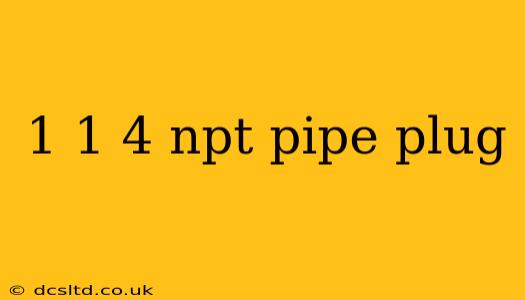Finding the right pipe plug is crucial for ensuring the safety and integrity of your plumbing system. A seemingly simple component, the 1 1/4 NPT pipe plug plays a vital role in sealing off unused pipe threads, preventing leaks, and maintaining pressure. This comprehensive guide explores everything you need to know about 1 1/4 NPT pipe plugs, from understanding the specifications to selecting the right material for your application.
What is a 1 1/4 NPT Pipe Plug?
A 1 1/4 NPT pipe plug is a threaded fitting designed to seal the end of a 1 1/4-inch National Pipe Taper (NPT) pipe. NPT threads are tapered, creating a tighter seal as they are screwed in. The plug's design ensures a leak-proof closure, preventing the escape of liquids, gases, or air pressure. The "1 1/4" refers to the nominal pipe size, while "NPT" specifies the type of thread.
What are NPT Threads?
NPT (National Pipe Taper) threads are a standard type of tapered pipe thread used in North America. The taper ensures a tight seal by creating compression as the threads are tightened. This is different from straight threads, which rely on gaskets or other sealing mechanisms for a leak-proof fit. Understanding this difference is essential for selecting the appropriate fittings for your project.
What Materials are 1 1/4 NPT Pipe Plugs Made From?
1 1/4 NPT pipe plugs are available in a variety of materials, each suited to different applications and environments:
- Brass: A common choice for its durability, corrosion resistance, and good machinability. Brass plugs are suitable for many applications but may not be ideal for highly corrosive environments.
- Steel: Offers superior strength and durability, making it ideal for high-pressure systems or applications requiring resistance to extreme temperatures. Steel plugs often require a protective coating to prevent corrosion.
- Stainless Steel: Provides excellent corrosion resistance, making it suitable for outdoor applications, chemical processing, and environments with high humidity. Stainless steel is more expensive than brass or steel.
- Plastic (e.g., PVC, Nylon): Lightweight and cost-effective, plastic plugs are suitable for lower-pressure applications where corrosion resistance is important. However, they may not withstand high temperatures or pressures as well as metal plugs.
The choice of material depends heavily on the specific application. Consider factors like pressure, temperature, chemical exposure, and budget when selecting the appropriate material.
How to Install a 1 1/4 NPT Pipe Plug?
Installing a 1 1/4 NPT pipe plug is generally straightforward:
- Clean the threads: Ensure the pipe threads are clean and free of debris to ensure a proper seal.
- Apply sealant (optional): While not always necessary, applying a thread sealant (like Teflon tape or pipe dope) can enhance the seal and prevent leaks, especially in high-pressure applications.
- Screw in the plug: Carefully screw the plug into the pipe threads by hand until it is snug. Use a wrench to tighten further, but avoid over-tightening, which can damage the threads.
What are the Different Types of 1 1/4 NPT Pipe Plugs?
While the basic functionality remains the same, minor variations can exist:
- Hex Plugs: These have a hexagonal head for easy tightening and loosening with a wrench.
- Square Plugs: Similar to hex plugs, but with a square head.
The choice between hex and square plugs is largely a matter of preference and the tools available.
Where Can I Buy 1 1/4 NPT Pipe Plugs?
1 1/4 NPT pipe plugs are widely available from various sources, including:
- Hardware stores: Local hardware stores typically carry a range of pipe fittings, including plugs.
- Plumbing supply stores: These stores offer a wider selection of fittings and materials, often including specialized options.
- Online retailers: Online marketplaces provide convenient access to a large selection of pipe plugs from different manufacturers.
This guide provides a comprehensive overview of 1 1/4 NPT pipe plugs. Remember to always choose the correct material and size for your specific application and to follow proper installation procedures to ensure a secure and leak-free seal. Consult with a qualified plumber if you have any doubts or are working on a complex plumbing system.
